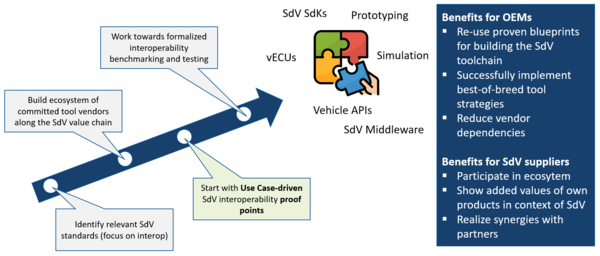Our goal is to support interoperability along the SdV tool chain, including tools for SdV prototyping, model simulation, cloud-based SdV testing, and deployment on vehicle computers. This page provides an overview of the different inter::op proof points.
Introduction
The traditional approach for vehicle development assumes a traditional, planning-centril approach, which includes development phases from definition and concept over pre-development and series development to pre-series and series production.
With SdV and the "digital first"-approach, digital and physical development are defined as two separate value streams, moving at different speeds and managed with different methods and methodologies. The physical value stream continues to be managed by methods like the V-model (especially important for verification and validation of functional safetly-related components), in combination with Model-based Sytems Engineering (MBSE). The digital value stream is utilizing best practices from the agile world.
Both value stream will utilize different tools, from requirements management to modeling, development and testing. SdV inter::op aims to support OEMs with building best-of-breed toolchains to support both, the digital and physical value steams, and how they are interacting.
SdV inter::op initiative
The approach taken by the digital.auto SdV inter::op initiative is to start by identifying relevant SdV standards, with a focus on interoperability. For example, vehicle APIs are playing an important role here, plus mappings of these APIs to different programming languages. Next, the goal is to build an ecosystem of committed tool vendors along the SdV value chain. Since it will be impossible to capture all standards and different types of tools from the beginning, inter::op will start with a very use case driven approach, creating inter::op proof points for specific use cases. Over time, this work will then be more formalized and eventually resulting in a more complete inter::op test suite.
SdV inter::op categories
SdV inter::op is focusing on two main interoperabiltiy categories. First, inter::op is looking at the interoperability between the north-bound and the south-bound side of the Vehicle API. De-coupling the digital value stream from the physical value stream is a key prerequisite for gaining agility in SdV development. Consequently, this is the first category. This will include vehicle API definition languages, as well as their mappings to specific programming languages, as well as transportation protocols, and finally SdV semantics (e.g. SdV ontologies). A good example here is the Vehicle Signal Specication (VSS) from the Connected Vehicle Systems Alliance (COVESA). This is one of the first standards in this category that SdV inter::op will be focusing on.
Second, SdV inter::op is looking at tool interoperability within a single SdV value stream. In the digital value stream, the project will look at how easy it is to migrate SdV code from environment to the other. For example, is it possible to re-use SdV code from a prototyping envionment in a proper development environment. And how about migration of code from cloud test-environments to vehicle computer runtimes.
Initially, all these tests will be specific to particular combinations of tools, and sometimes even to specific use cases. However, over time, this should evolve into a fairly generic SdV inter::op matrix, which shows interoperability between all tools tested.
Steve Crumb, Founding Executive Director, COVESA: “Interoperability along the development toolchain will be critical for the success of the Software-defined Vehicle, from early-stage prototyping to simulation to deployment in the cloud and on-board the vehicle. COVESA standards are playing an important role here. We welcome the digital.auto SdV inter::op initiative and look forward to the continued collaboration”
SdV inter::op proof points
The following describes the initial list of SdV inter::op proof points which has been created in 2022. Please contact us via email (info@digital.auto) should you be interested in learning more, or you want to participate in one of our next plug fests.
| Participating Companies | Use Case | SdV inter::op standards | Category 1 (Vehicle API interop) | Category 2 (Process interop) |
|---|---|---|---|---|
| ANSYS, IPG Automotive, Bosch, AIoT Lab Heilbronn | SdV interop: Anti-Kinetosis | COVESA VSS | SdV client + simulation backend | |
| AWS, Bosch | Weather Warning | COVESA VSS, CAN | SdV client + CAN feeder | |
| Bosch, Dassault Systèmes | Passenger Welcome | COVESA VSS | SdV client + simulation backend | |
| EPAM | Condition Monitoring | COVESA VSS | CSdV client / CAN simulator | Code deployment from prototyping to vehicle runtime |
| LeanIX | Value Stream Management | COVESA VSS | Automatic import of VSS into VSM tool | |
| Microsoft, Bosch | Dog Monitoring | COVESA VSS, DTDL | SdV client and DTDL feeder | |
| RTI | Condition Monitoring | COVESA VSS, DDS | SdV client and DDS feeder |



